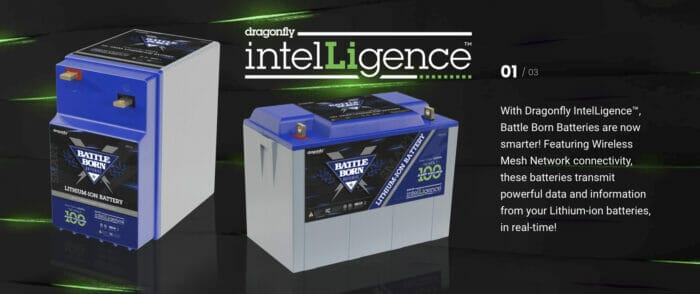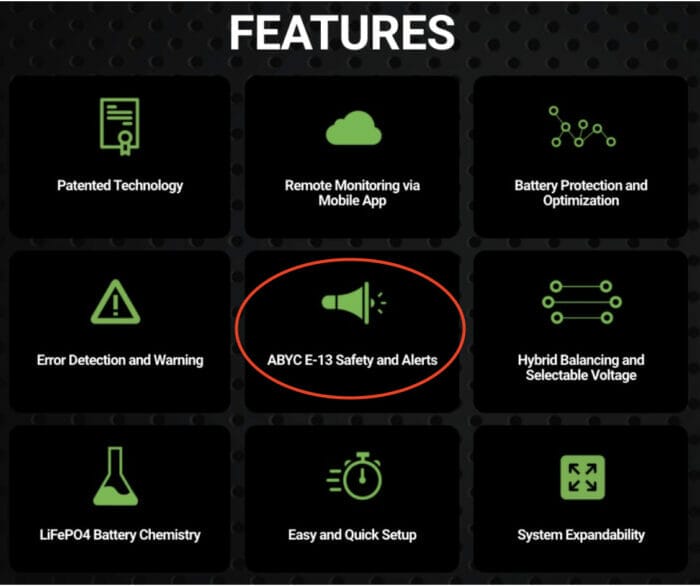
Great to see that one of the largest vendors of lithium batteries has finally got wise to the fact that when used on boats, lithium batteries with an internal BMS must be able to communicate with external devices and the user to be safe and compliant.
That said, Battle Born are making a lot of noise about the phone app (user communications) but are ominously quiet about CAN bus communication, which is the best way to manage a safe and functional marine installation.
However, given that Dragonfly, the parent company of Battle Born (not to be confused with Firefly Batteries), bought Wakespeed last year, hopefully Al Thomason, designer of the best alternator regulator out there, the WS5000, will pull levers behind the scenes to make sure they actually do this right, rather than just produce a pretty phone app to bamboozle the non-technical.

One other point, Battle Born are making a big deal out of now being ABYC compliant with this announcement, but kind of glossing over the fact that, as I read the standard, all of the tens of thousands (guess) of batteries they have sold to yachties over the years without these features are not compliant.
I wonder how long it will be before insurance companies start requiring ABYC E-13 compliance before renewal? Could be a lot of secondhand Battle Born batteries looking for a home, and some very pissed off boat owners.
Seems to me that the very least Battle Born should do is offer a very nice discount on the new batteries to anyone who bought the old batteries, say in the last two years. Some sort of trade-in would be even better. Heck, maybe they could even upgrade the old batteries with the new communications technology.
Anyway, moral of the story: Don’t buy batteries with an internal BMS that can’t communicate with charging sources or warn you before things go wrong.

Good to see progress. Interestingly, I see no sign of an external communication port on their batteries in the picture. Maybe they are indeed relying on Bluetooth …
Hi Richard,
I’m pretty sure they are doing exactly that. If so, classic example of sizzle to fool the unwary, rather than sausage to make the system better. “Give ’em a phone app and the suckers will buy it every time”.
There is a Hub that connects to each battery with bluetooth. That hub monitors each battery SOC, charge rate, balancing status, ect and aggregates the data. It connects with CAN, N2k, and bluetooth to other devices, including having programable relays to set off various alarms or trigger contactors.
Hi Conor,
You know this for sure? If so, please link me to your source. I don’t think that’s yet finalized. I also don’t like the idea of using bluetooth for process control. Bluetooth, while fine for monitoring, is not a mission critical method for process control. They mention “mesh” which is WiFi, but even then a hard wire would be safer.
Panbo seems to have more detail on the system than is publicly available from Dragonfly. Here’s a quote from the article: “The Hub allows connectivity to other devices via BlueTooth, NMEA 2000, RV-C, Victron’s VE.Bus, and Ethernet.”
What isn’t clear is how the batteries connect to the Hub. A Dragonfly video indicates a wireless mesh.
There is no plan to make all of their existing batteries interoperable with the new system.
Hi Mike,
Lots of claims, I agree, no product yet though. I fear we are seeing a lot of vapour ware here. In my view Battle Born have a history of focusing on sizzle to sell, rather than sausage to make the system robust. These are the people that told us that all we had to do was “drop in” when that was not true or safe on a boat: https://www.morganscloud.com/2022/04/25/why-lithium-battery-load-dumps-matter/
If it were say Victron or Mastervolt, companies with a long term recored of fully functioning systems, I would be way less sceptical.
I agree there is little published about the system and the details are still being worked out.
Search for: Dragonfly intelLIgence Hub. The best source, although relatively brief, still appears to be this PDF:
https://s201.q4cdn.com/601240956/files/Dragonfly-IntelLigence-Announcement-Presentation-V7-01.14.2023.pdf
good point.
I think there is (quite) some confusion about BMS’s and the role they play. In simple terms, an internal BMS protects the individual battery and manages some processes (like cell balancing). An external BMS protects the battery bank (multiple) on system level and manages some other processes, including things like charging to SOC levels, allow/disallow (dis)charge, etc.
Communication from a battery (internal BMS) gives data to the external BMS and the rest of the system (solar chargers, alternator protect, inverters, etc) how to behave so the whole systems works as designed. An internal BMS in a system with multiple batteries can’t manage this as it works on battery level. For a simple system you might not notice the lack of function without external BMS. But systems on boats are often already complex with multiple sources of charging (solar, motor, gen, wind al together). Without external BMS the system becomes inefficient at best and wonky around the design edges or simply unreliable. That integration is a lot harder if your battery doesn’t communicate what’s going on till it simply switches off!
For example. In a system without integration a charger uses an algorithm (read assumptions) on charge voltage, current, etc. In a Victron system, the smart battery tells the BMS what charge current/voltage it actually needs. The charge algorithms are disabled and the chargers use the same voltage etc throughout all chargers to optimize charging as efficiently and safe as possible based on what the batteries say they can handle instead of a charger thinking: “well, I think it should…)
For protection, an internal BMS should be seen more as a last resort fail-stop (again of the battery only). It’s like not having brakes on your car and relying on the ABS to avoid an accident.
An external BMS will protect the system, incl batteries, on system level, including things like warning for load dump, stop discharging at a % SOC to extend battery life, temperature control, etc.
Having a battery that “can communicate” is not enough. The key is that is can be understood by a BMS. E.g., I would look first and foremost if a Batle Born communication is compatible with the external BMS or something else that manages the system. Nice graphs on a smartphone are not very useful if the rest of the systems doesn’t understand the protocol. (Even if it’s NMEA2k.) CANbus beats Bluetooth in my opinion. But Bluetooth seems to work as reliable so far as well if you can’t wire it.
The key is to design the electrical system as a whole. Not to just drop in a Li-battery for more power and cross your fingers. Not even if it is a smart battery used in a not-so-smart way.
Hi Maarten and Marga,
I agree with your basic premise. In fact I have written the same at length:
https://www.morganscloud.com/2022/05/02/8-tips-to-prevent-lithium-battery-load-dumps/
https://www.morganscloud.com/2022/04/25/why-lithium-battery-load-dumps-matter/
However, while it is true that companies like Victon put some cell management circuitry inside their batteries intended to work with external BMSs, I have not seen a system where internal and external BMSs work together. All systems I have seen are either internal or external, not both.
There are also internal BMSs that can control the entire system, and work together with other BMSs, in just the way that external ones do. Mastervolt is an example.
Anyway, the key point is, as you say, the whole works needs to be designed as a system to work together with charge sources. I also agree that BlueTooth is not the protocol to use for this process control, but rather CANbuss or something like it. Bluetooth is fine for monitoring but a system that use BlueTooth to control charging sources would get the thumbs down from me.